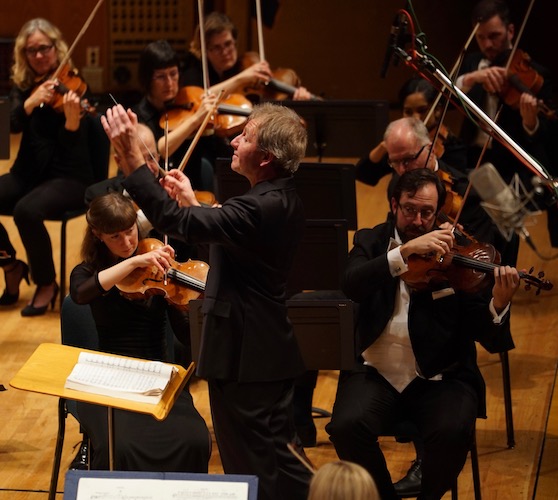Fischer, Utah Symphony explore lighter Berlioz, dark Tchaikovsky

Thierry Fischer conducted the Utah Symphony in music of Wagner, Berlioz and Tchaikovsky Friday night at Abravanel Hall. Photo: Kathleen Sykes
This week’s Utah Symphony program features three short pieces by Berlioz that will be included in the orchestra’s all-Berlioz album for Hyperion to be released in 2020. (The centerpiece of the CD is the Symphonie fantastique which the orchestra and Thierry Fischer recorded at last weekend’s concerts.)
Friday’s performance in Abravanel Hall proved yet again that Fischer is indeed a sound interpreter of the French composer’s music. The three pieces (Sara la baigneuse, La Mort d’Ophélie and Rêverie et caprice)—averaging about 10 minutes each and scored for vastly reduced forces—showed that Berlioz was capable of creating vivid imagery and imaginative scoring on a much smaller scale.
Joining Fischer and the orchestra for Sara la baigneuse were the Utah Symphony Chorus and the University of Utah Chamber Choir. Set to a poem by Victor Hugo, the work is lushly exotic. Fischer captured the sensuality of the music with clearly defined expressions and fluid lyricism. His tempo was leisurely and let the music unfold gracefully. He brought a fine balance between the combined choirs and the orchestra, never letting one overshadow the other. And the well-blended voices of the choirs brought a richness that underscored the indulgent nature of the music.
In La Mort d’Ophélie the chorus is reduced to women’s voices, and once again the vocal ensemble captured the raw emotion of the music with its finely honed lyrical singing. Fischer’s sensitive direction emphasized the heartfelt sorrow that Berlioz poignantly paints over the death of Ophelia.
The third piece, Rêverie et caprice, for violin and orchestra, is perhaps the best known of this group. This is a gorgeously mellifluous and charming piece that is a fine showcase for the soloist’s lyrical side.
Violinist Philippe Quint, the Utah Symphony’s artist-in-association, joined the orchestra and Fischer for a wonderfully lyrical account of this piece. Quint displayed his musicality to the fullest, giving a vibrant account of the opening that captured the dream-like character of the Rêverie, while underscoring the airy, animated spirit of the ensuing caprice. Fischer offered a subtle yet solid accompaniment that let his soloist shine.
The concert opened with a decidedly un-French piece, the overture to Wagner’s opera Tannhäuser. Fischer brought a seamless flow and fine cohesiveness to the piece, allowing the music’s various sections to unfurl at a well-defined pace. The horns of the symphony displayed their expressive chops in the stately opening measures, playing with a rich, burnished sound. And Fischer equally captured the sensuality of the “Venusberg” music, the solemnity of the pilgrims’ march to Rome and the vibrancy of the singer contest in a carefully executed reading.
For the second half, Fischer took the audience to Russia with a marvelous performance of Tchaikovsky’s Symphony No. 6. For this work, Fischer changed the seating arrangement onstage and spread the contrabasses along the back behind everyone else.
This isn’t Fischer’s first outing with the Sixth with the Utah Symphony, but Friday’s performance was without question his best “Pathetique” interpretation to date. He had a definite vision of the work — allowing the first three movements to act as a grand prelude to the powerful closing Adagio.
From the start one knew that this performance was going to be special. Fischer began by underscoring the melancholia of the first movement’s introductory Adagio before seamlessly moving into the robust opening theme of the first movement proper. This, in turn, gave way to an unhurried, expressively phrased and delivered second theme. Fischer took it much slower than expected, but he avoided the pitfall of turning this theme into sentimental mush. It was given a lyrical and beautifully melodic turn that underscored the richness of the motif.
The dance-like second movement flowed with rhythmic energy. Fischer took it at a sprightly tempo that worked well and was a perfect foil to the intensity of the opening movement. The march was infused with force and relentless drive. Once again, Fischer took it at a fast clip and it seemed to be over almost as soon as it began.
In the final Adagio, Fischer captured the anguish, sadness and sense of resignation that Tchaikovsky created with heart-wrenching poignancy. The composer bares his soul in this movement and Fischer’s sensitive account rendered these powerful emotions with sincerity, bringing cohesion and a sense of emotional closure to the work as a whole.
The program will be repeated 7:30 p.m. Saturday in Abravanel Hall. utahsymphony.org; 801-355-2787.